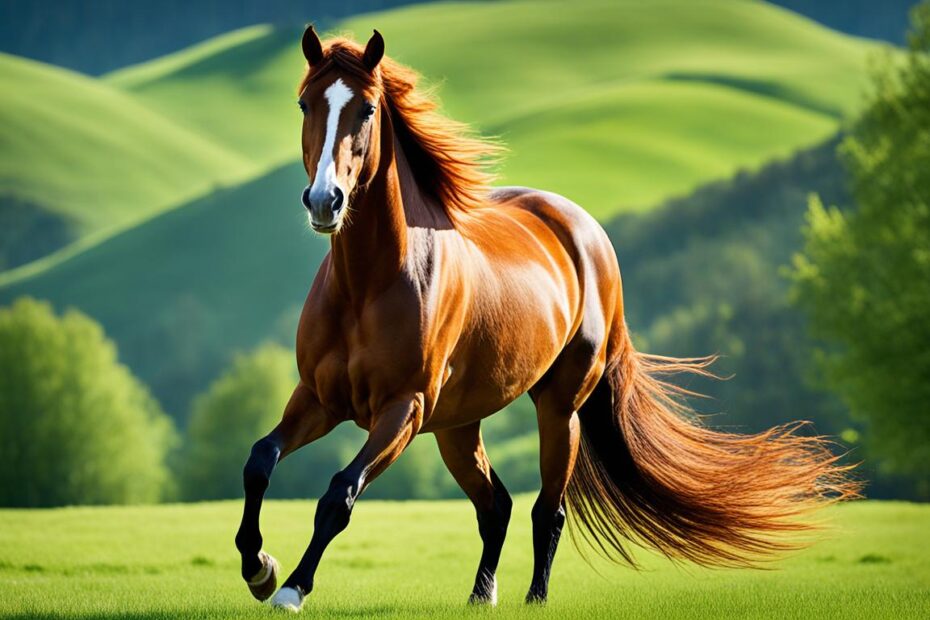In the captivating realm of equine conservation, a remarkable surge of philanthropic initiatives is emerging, harnessing the power of biotechnology to revive endangered and ancient horse breeds.
These visionary projects are leveraging the latest advancements in cloning and genetic preservation, offering a glimmer of hope for the restoration of iconic equine species that once roamed the earth.
From the mystical Przewalski’s horse to the majestic Tarpan, these philanthropic endeavors are dedicated to safeguarding the rich tapestry of equine heritage, ensuring that the genetic legacies of these remarkable creatures are not lost to the sands of time.
By harnessing the power of horse DNA, these trailblazing initiatives are breathing new life into the world of equine conservation, igniting a global movement to protect and preserve the remarkable diversity of our equine companions.
Key Takeaways
- Philanthropic projects are using horse DNA to clone and revive ancient and endangered equine breeds.
- Genetic preservation techniques, such as cloning, are shaping the future of equine conservation and heritage restoration.
- These initiatives are dedicated to safeguarding the rich tapestry of equine heritage, ensuring the genetic legacies of remarkable horse species are not lost.
- Harnessing the power of horse DNA, these projects are breathing new life into the world of equine conservation.
- The goal is to protect and preserve the remarkable diversity of our equine companions for generations to come.
Introduction to Equine Conservation
Equine conservation is a crucial endeavor that seeks to preserve rare and endangered horse breeds, safeguarding their genetic diversity and historical significance.
These ancient equine species are not only culturally and ecologically valuable but also hold the key to unlocking fascinating insights into our shared past.
Importance of Preserving Rare Breeds
Rare horse breeds are precious repositories of genetic information, representing centuries of adaptation and evolution. Preserving these heritage breeds is essential for maintaining the overall health and resilience of the equine population.
Each breed possesses unique traits, from disease resistance to adaptability to harsh environments, which could prove invaluable in the face of emerging challenges.
Historical Significance of Ancient Horses
Ancient horse breeds are inextricably linked to the cultural and historical fabric of our world. These majestic animals have played pivotal roles in shaping human civilizations, from transport and warfare to agriculture and recreation.
By preserving their genetic legacy, we can better understand the evolution of equine species and their profound impact on the human experience.
The preservation of rare and endangered horse breeds is not merely a matter of academic interest but a crucial step in safeguarding our natural and cultural heritage. Through innovative approaches to equine conservation, we can ensure that these magnificent creatures continue to captivate and inspire generations to come.
Biotechnology and Cloning: A Promising Solution
In the realm of equine conservation, advancements in biotechnology, particularly in the field of cloning, offer a glimmer of hope for the revival of ancient and rare horse breeds.
By harnessing the power of genetic preservation, scientists and conservationists are able to explore innovative ways to protect these precious equine species from the brink of extinction.
The process of cloning involves the meticulous extraction and replication of an animal’s DNA, allowing for the creation of genetically identical offspring. This groundbreaking technology has the potential to breathe new life into endangered horse breeds, providing a crucial lifeline for their preservation.
Cloning not only offers a means of resurrecting lost lineages but also serves as a valuable tool for the conservation of valuable genetic diversity. By maintaining a repository of frozen genetic material, researchers can ensure that the unique genetic makeup of these ancient horses is safeguarded for future generations.
- Biotechnology advancements have revolutionized equine conservation efforts.
- Cloning techniques enable the revival of extinct or endangered horse breeds.
- Genetic preservation through cloning safeguards the diversity of ancient equine species.
| Biotechnology for Animals | Cloning Extinct Horses | Genetic Preservation |
|---|---|---|
| Leveraging scientific breakthroughs to protect vulnerable species | Resurrecting lost lineages and restoring historical horse breeds | Safeguarding the unique genetic diversity of ancient equine populations |
As the field of equine conservation continues to evolve, the promise of biotechnology and cloning stands as a beacon of hope for the preservation of these magnificent animals.
By harnessing the power of science, we can work to ensure that the rich tapestry of equine heritage is not lost to the sands of time.
Philanthropic Initiatives in Equine Restoration
In the realm of equine conservation, a growing number of philanthropic organizations are spearheading innovative projects to revive ancient and endangered horse breeds using advanced DNA technology.
These initiatives are not only preserving the genetic legacies of these iconic animals but also restoring their historical significance and cultural value.
Organizations Leading the Charge
At the forefront of these efforts are renowned conservation organizations such as the World Wildlife Fund, the International Union for Conservation of Nature, and the Smithsonian Institution.
These organizations are collaborating with leading scientific institutions and research centers to develop cutting-edge techniques for genetic sampling, DNA extraction, and ultimately, the cloning of rare equine species.
Funding Sources and Partnerships
The success of these philanthropic equine initiatives is largely dependent on the financial support and strategic partnerships that enable them to thrive. Private foundations, corporate sponsors, and government agencies have all played a crucial role in funding equine restoration projects across the globe.
These public-private partnerships have been instrumental in driving the research and development needed to realize the full potential of conservation organizations in preserving the world’s most unique horse breeds.
By harnessing the power of cutting-edge biotechnology and fostering collaborative efforts, these visionary philanthropic initiatives are paving the way for a future where the genetic legacies of ancient horses can be preserved and revived for generations to come.
The Science Behind Cloning Extinct Horses
Cloning extinct or endangered horse breeds is a fascinating field that combines the power of biotechnology and scientific principles.
At the heart of this endeavor lies the intricate process of genetic sampling and DNA extraction, which serves as the foundation for resurrecting these iconic equine species.
Genetic Sampling and DNA Extraction
The first crucial step in cloning extinct horses is obtaining a viable genetic sample. This often involves collecting tissue or hair samples from preserved remains or living descendants of the target breed.
Using advanced biotechnological techniques, researchers can then extract the precious DNA from these samples, unlocking the genetic code that holds the key to their unique characteristics.
The extracted DNA is meticulously analyzed, with scientists studying the genetic markers and sequences that define the breed’s distinct features. This comprehensive understanding of the genetic blueprint allows researchers to create a detailed map, paving the way for the subsequent cloning process.
- Genetic sampling: Collecting tissue or hair samples from preserved remains or living descendants
- DNA extraction: Isolating the genetic material from the collected samples
- Genetic analysis: Studying the DNA to uncover the unique characteristics of the target breed
With the genetic data in hand, scientists can then employ various cloning techniques, such as somatic cell nuclear transfer (SCNT), to generate viable embryos and ultimately bring these ancient horse breeds back to life.
The complex science behind equine cloning continues to evolve, offering hope for the restoration and conservation of these remarkable creatures.
Ethical Considerations in Equine Cloning
As the field of equine cloning continues to advance, it is crucial to carefully consider the ethical implications of these practices. While the potential benefits of cloning rare and endangered horse breeds for conservation efforts are significant, there are complex ethical issues that must be addressed.
One of the primary concerns is the welfare of the cloned horses. Cloning can pose risks to the health and well-being of the animals, and it is essential to ensure that proper protocols and safeguards are in place to minimize any potential suffering.
Responsible breeders and researchers must prioritize the ethical treatment of the horses and adhere to rigorous animal welfare standards.
| Ethical Considerations | Potential Concerns |
|---|---|
| Animal Welfare | Risks to the health and well-being of cloned horses |
| Regulatory Frameworks | Lack of clear guidelines and oversight for equine cloning |
| Conservation Efforts | Potential for unintended consequences or unintended genetic diversity loss |
Another crucial consideration is the regulatory framework surrounding equine cloning. Currently, there is a lack of clear and consistent guidelines governing these practices, which can lead to inconsistencies and potential ethical breaches.
Policymakers and regulatory bodies must work to establish robust frameworks that ensure the responsible and ethical use of cloning technology in the equine industry.
Furthermore, the impact of equine cloning on conservation efforts must be carefully evaluated. While cloning can aid in preserving rare and endangered breeds, there is a risk of unintended consequences, such as the loss of genetic diversity.
Researchers and conservation organizations must collaborate to develop strategies that balance the benefits of cloning with the need to maintain the overall health and resilience of horse populations.
As the field of equine cloning continues to evolve, it is essential that the ethical considerations are at the forefront of any research or conservation initiatives.
By prioritizing animal welfare, establishing robust regulatory frameworks, and carefully evaluating the impact on conservation efforts, the equine community can ensure that the benefits of these technologies are realized in a responsible and ethical manner.
Philanthropic Projects Using Horse DNA to Clone Ancient Breeds
In the realm of equine conservation, philanthropic initiatives have emerged as a driving force in reviving ancient and endangered horse breeds.
By leveraging the power of biotechnology and cloning, these projects are making significant strides in preserving the genetic diversity and historical legacy of some of the world’s rarest equine species.
One pioneering effort is the “Equus Ferus Restoration Project,” led by a team of passionate geneticists and conservationists. This initiative has made remarkable progress in cloning the DNA of the Przewalski’s horse, a critically endangered subspecies native to the Mongolian grasslands.
Through meticulous genetic sampling and extraction, the project has been able to resurrect these iconic horses, offering a glimmer of hope for their long-term survival.
Another exemplary project is the “Tarpan Rebirth Initiative,” which focuses on reviving the Tarpan, a hardy, primitive horse breed that was once ubiquitous across Europe.
By collaborating with leading universities and research institutions, this philanthropic endeavor has made significant strides in unlocking the genetic secrets of the Tarpan, paving the way for its eventual reintroduction into the wild.
| Project | Focus | Key Achievements |
|---|---|---|
| Equus Ferus Restoration Project | Przewalski’s Horse | Successful cloning of the critically endangered subspecies |
| Tarpan Rebirth Initiative | Tarpan | Advancements in genetic research and conservation efforts |
These philanthropic projects, powered by the latest advancements in cloning technology, are not only reviving rare equine breeds but also preserving the cultural and historical significance of these majestic animals.
By safeguarding the genetic legacy of these ancient horses, these initiatives are ensuring that future generations can marvel at the wonders of equine biodiversity and appreciate the rich tapestry of our shared equine heritage.

Reviving Heritage Breeds: Success Stories
In the captivating world of equine conservation, philanthropic efforts have achieved remarkable success in resurrecting iconic horse breeds from the past.
These inspiring stories showcase the transformative power of genetic preservation, serving as beacons of hope for the revival of our equine heritage.
Iconic Breeds Resurrected
One triumphant example is the revival of the Tarpan, a wild horse species that had been declared extinct in the 20th century. Through meticulous DNA analysis and cloning techniques, the Tarpan has been reintroduced to the wild, offering a glimpse into the past and rejuvenating the genetic diversity of the equine kingdom.
Another remarkable success story is the resurrection of the Przewalski’s Horse, often referred to as the “true wild horse.” Once on the brink of extinction, this iconic breed has been brought back from the brink, thanks to the tireless efforts of conservation organizations and the application of cutting-edge cloning technology.
| Breed | Status | Conservation Efforts |
|---|---|---|
| Tarpan | Revived | DNA analysis, cloning |
| Przewalski’s Horse | Resurrected | Conservation organizations, cloning |
These equine conservation success stories serve as shining examples of the remarkable achievements that can be attained through the committed efforts of philanthropists, scientists, and breed enthusiasts.
By reviving these iconic breeds, we not only preserve our cultural heritage but also contribute to the genetic diversity and resilience of the equine world.
Challenges and Limitations
While the prospect of reviving ancient and endangered horse breeds through cloning is undoubtedly exciting, philanthropic projects in this field face a range of challenges and limitations. Technological hurdles and regulatory frameworks pose significant obstacles that must be navigated with care.
Technological Hurdles
Cloning horses is a complex and delicate process, fraught with uncertainties. Achieving viable, healthy clones with the desired genetic characteristics is a significant technological challenge. Low cloning success rates, genetic abnormalities, and issues with cellular viability can all hamper the efforts of organizations working to conserve equine heritage.
Regulatory Frameworks
The regulatory landscape surrounding equine cloning varies widely across different regions and jurisdictions. Navigating the maze of laws, guidelines, and ethical considerations can be a daunting task for philanthropic groups.
Ensuring compliance with these frameworks while also advocating for more permissive and supportive policies is crucial for the long-term success of these conservation initiatives.
| Challenges and Limitations | Description |
|---|---|
| Technological Hurdles | – Low cloning success rates – Genetic abnormalities – Issues with cellular viability |
| Regulatory Frameworks | – Varying laws and guidelines across regions – Navigating ethical considerations |
Despite these challenges, philanthropic organizations remain committed to finding innovative solutions and overcoming the hurdles to preserve the genetic legacy of ancient and endangered horse breeds. Ongoing research, collaboration, and advocacy will be crucial in shaping the future of equine conservation through cloning technologies.
The Future of Equine Conservation
The future of equine conservation looks promising, thanks to the rapid advancements in biotechnology and the growing momentum of philanthropic initiatives. As the field of genetic preservation continues to evolve, the revival and protection of ancient and endangered horse breeds have become more attainable than ever before.
One of the key drivers of this progress is the increasing accessibility of cloning technologies. Researchers and conservation organizations are leveraging these breakthroughs to bring back iconic horse breeds that were once on the brink of extinction.
By extracting and preserving the genetic material of these rare equines, they can now create genetically identical offspring, ensuring the survival and diversification of these precious lineages.
Alongside the technological advancements, the role of philanthropic initiatives cannot be overstated. Passionate individuals, foundations, and organizations have stepped up to provide the necessary funding and resources to support these critical conservation efforts.
From establishing specialized breeding programs to investing in state-of-the-art research facilities, these philanthropic efforts are paving the way for a future where equine diversity is not only preserved but actively celebrated.
As we look ahead, the future of equine conservation holds the promise of even greater breakthroughs. Emerging technologies, such as advancements in genome editing and artificial insemination, may further enhance the success of these revival programs.
Additionally, the increased collaboration between scientists, policymakers, and equine enthusiasts is fostering a more holistic approach to preserving these majestic animals and their cultural heritage.
The road ahead may not be without its challenges, but the commitment and ingenuity of those dedicated to equine conservation are undoubtedly shaping a future where rare and endangered horse breeds can thrive once more.
With the continued support of scientific advancements and philanthropic initiatives, the revival of these ancient equines holds the potential to inspire generations to come, preserving a vital piece of our shared equestrian legacy.

| Key Factors Driving the Future of Equine Conservation |
|---|
| Advancements in biotechnology and cloning technologies Increased funding and support from philanthropic initiatives Collaborative efforts between scientists, policymakers, and equine enthusiasts Emerging technologies, such as genome editing and artificial insemination Commitment to preserving the genetic diversity and cultural heritage of rare horse breeds |
Preserving Historical Legacy Through Genetic Revival
The philanthropic efforts to resurrect ancient horse breeds using DNA technology have far-reaching implications beyond the preservation of equine biodiversity.
These groundbreaking initiatives are not only safeguarding the historical legacy of these iconic equine species but also fostering a deeper cultural and educational appreciation for the rich heritage they represent.
Cultural and Educational Impact
By reviving rare and endangered horse breeds, these philanthropic projects are helping to revitalize the cultural significance and connections that these animals have held throughout history.
From their roles in ancient warfare and agricultural practices to their symbolic representations in art and mythology, the restoration of these breeds serves to reinvigorate the authentic narratives and traditions that have been intertwined with equine heritage for centuries.
Moreover, the educational value of these endeavors cannot be overstated. Through educational programs, museum exhibits, and interactive experiences, the public is granted a unique window into the storied pasts of these remarkable horse breeds.
This enhanced understanding not only sparks a renewed appreciation for the evolutionary and historical journeys of these animals but also inspires future generations to become stewards of this invaluable equine legacy.
FAQ
What is the purpose of using horse DNA to clone ancient breeds?
The primary purpose of using horse DNA to clone ancient breeds is to revive and preserve endangered or extinct equine species. These philanthropic efforts aim to restore the genetic diversity and historical legacy of iconic horse breeds through the power of biotechnology and cloning.
What are the key organizations leading the charge in equine conservation using cloning?
Several philanthropic organizations, such as the Revive & Restore Foundation, the International Equine Conservation Trust, and the Equus Survival Trust, are at the forefront of using horse DNA and cloning to revive ancient and endangered breeds.
These groups collaborate with researchers, scientists, and other stakeholders to fund and spearhead these innovative conservation initiatives.
How does the cloning process work to bring back extinct horse breeds?
The cloning process for extinct or endangered horse breeds involves several steps. First, genetic samples are collected from preserved remains or living descendants of the target breed. The DNA is then extracted and used to create viable embryos through various biotechnological methods.
These embryos are then implanted into surrogate mares, with the goal of successfully gestating and birthing cloned foals that can help revive the historical lineage of the breed.
What are some of the ethical considerations surrounding equine cloning for conservation?
While the prospect of reviving ancient horse breeds is exciting, there are important ethical considerations that must be addressed. These include concerns around animal welfare, potential health risks to cloned horses, and the broader implications of using biotechnology to resurrect extinct species.
Philanthropic organizations involved in these initiatives must ensure that they adhere to strict regulatory frameworks and ethical guidelines to minimize any negative impacts.
What are some success stories in reviving heritage horse breeds through cloning?
Some notable success stories include the resurrection of the Tarpan, a wild horse breed that was believed to be extinct, and the cloning of the Przewalski’s horse, a critically endangered species. These achievements demonstrate the potential of using horse DNA and cloning to bring back iconic equine breeds and help preserve their genetic and cultural legacies.
What are the main challenges and limitations faced by philanthropic projects in this field?
Philanthropic projects focused on cloning ancient horse breeds face several challenges, including technological hurdles in achieving successful cloning, regulatory frameworks that must be navigated, and the need for long-term funding and resources to sustain these conservation efforts.
Additionally, there are ethical concerns and public perceptions that must be carefully considered and addressed.

